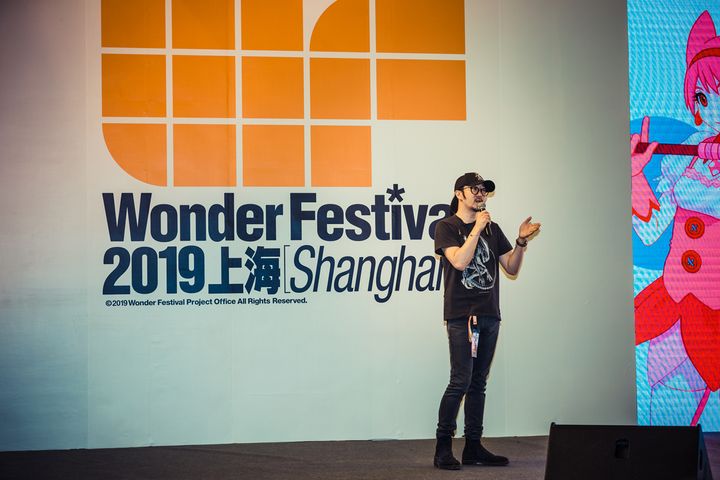 The GK World Meets the Chinese Market
The GK World Meets the Chinese Market(Yicai Global) June 21 -- Pottery figures modeled on Qin Dynasty (221-207 BCE) terracotta warriors sat next to Iron Man and other Marvel superheroes. Porcelain deer from the Book of Songs bounded beside the Night King from Game of Thrones.
These items were the garage kits Chinese fans at the recent Wonder Festival 2019 Shanghai went crazy for.

It seems strange for average visitors, but quite common for sector insiders. Hundreds of thousands of enthusiasts were drawn to the event where art toys, Sofubi -- which means 'soft vinyl' in Japanese, refers to both the material and the style of crafting figures in it -- and high-end action figures were the licensed merchandise of one-of-a-kind pieces from around the world.
Capital has flooded into China's animation sector since 2016, and this has also resulted in the booming growth of animation derivatives, above all polyvinyl-chloride figurines and GKs. Core consumers of the animation culture in China reached 80 million in 2017, data from domestic industry research institutions show, and the market size for its products topped CNY10 billion (USD1.46 billion) in 2016.
Sniffing the increasing popularity of the country's animation culture has lured established Japanese and US companies to start to make inroads into the Chinese market.
"China is really exciting," said Frank Kozik, a well-known American designer who participated in the Wonder Festival 2019. "In the United States, the ratio of male to female consumers is about nine to one. In China, the ratio is about one to one."
Chinese consumers are generally much younger than Japanese ones, most of whom are over 35 years old, said Shuichi Miyawaki, the chairman of Osaka-based GK producer Kaiyodo. He brought the 35-year-old Wonder Festival to China last year and turned it into a regular event.
Some Japanese prototype designers find that their Chinese counterparts are very innovative and willing to cooperate with them, he added.
Domestic designers and producers of animation figures and GKs have sought to merge Chinese elements into the pop trend while museums have also started to play a key part in this process.
"Many designs on the Chinese Wonder Festival are very original, unlike some derived from manga or movie intellectual property in American and Japanese shows," said Spidertoys, who oversaw a contest hosted by Beijing-based 52Toys and the Shaanxi History Museum to bring cultural relics back to life with modern innovative designs.
The competition, which was Held in October, attracted over 300 works from around the world, not only those with strong Chinese features, such as dancing pottery figures, but also some Sumerian- and Egyptian-style ones, Spidertoys said.
The Shaanxi History Museum, drawing inspiration from the Terracotta Army, has introduced a series of animation figures named the King's Soldiers. These were quickly snapped up after their debut on the Taobao e-commerce platform of tech titan Alibaba Group Holding.
The history museum is not alone. The Palace Museum, one of the most prestigious such institutions in China, has also discovered the secret of the younger generation's love for animation figures.
The total turnover of cultural and creative products at the Palace Museum reached CNY1.5 billion (USD218 million) in 2017. This figure exceeded the revenue of 1,500 companies listed on mainland stock markets that year.
Liu Ziyu, who graduated college two years ago and works as a public relations agent, bought two tubes of Palace Museum co-branded lipstick for his girlfriend. "Most items at the Palace Museum are inexpensive, but very eye-catching," he said .
The most expensive one-off at the Wonder Festival was a traditional Japanese instrument named a Shamisen produced by famous game illustrator Yoshitaka Amano and a well-known musical instrument dealer, was priced at CNY150,000 (USD21,850).
Facing the fans and capital in this huge market, ever more Chinese animation designers are trying to launch their own labels and establish signature IP to compete in the field. Manas Workshop is one of these.
Formed in 2010, it is the first Chinese studio specializing in original modeled figures, and one of the best teams in high-end GK pieces renowned for their delicacy. Their products are mainly based upon Chinese myths and legends. For example, the series based on the classic Journey to the West presents scenes from the novel.
"Manas has been trying to extract something new from China's [cultural] legacy since its establishment," said its co-founder and creative director Xu Jinpeng.
"I started with Japanese GK like Gundam, and now I'm starting to collect some Chinese-style creative works," said a visitor surnamed Zhang Quan in his 20s waiting in a long queue to have his purchase signed. Brought up in a very affluent family, he has rich experience in GK.
"In the past, most Chinese PVC figures were poorly designed or produced, lacking craftsmanship. Now it is getting much better, and to be honest, I prefer ancient Chinese myths and old-time generals to American superheroes," he added.
Editor: Ben Armour